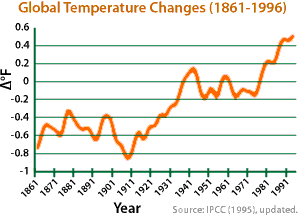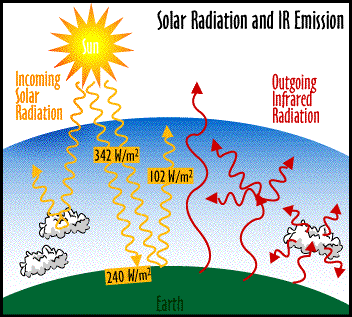
Climate Change
Human activities have caused much of the destruction of the world’s coral reefs. For example, human-induced global climate change may be causing an increase in ocean temperatures. This is suspected to be a major culprit of coral loss.
Global climate change is a change in the long-term weather patterns that characterize the regions of the world. Weather refers to the short-term (daily) changes in temperature, wind, and/or precipitation of a region (Merritts et al., 1998). Weather is influenced by the sun. The sun heats the Earth's atmosphere and its surface, causing air and water to move around the planet. The result can be as simple as a slight breeze or as complex as the formation of a tornado.
When weather patterns for an area change in one direction over long periods of time, they can result in a net climate change for that area. The key concept in climate change is time. Natural changes in climate usually occur over geologic time. That means they occur over such long periods of time that they are often not noticed within several human lifetimes. The gradual nature of these climate changes enables plants, animals, and microorganisms to evolve and adapt to the new temperatures, precipitation patterns, etc.
 The real threat of climate change lies in how rapidly the change occurs. For example, over the past 130 years the mean global temperature appears to have risen 0.6 to 1.2 degrees Fahrenheit (0.3 to 0.7 degrees Celsius). Look at the temperature changes depicted in the graph from the
Environmental Protection Agency's Global Warming web site. The increasing steepness of the curve suggests that changes in mean global temperature have occurred at greater rates over time. Further evidence suggests that future increases in mean global temperature may occur at a rate of 0.4 degrees Fahrenheit (0.2 degrees Celsius) each decade. Graph: This shows the changes in global temperature (degrees Fahrenheit) from 1861 to 1996. Graph adapted from image courtesy of the U.S. Environmental Protection Agency.
The real threat of climate change lies in how rapidly the change occurs. For example, over the past 130 years the mean global temperature appears to have risen 0.6 to 1.2 degrees Fahrenheit (0.3 to 0.7 degrees Celsius). Look at the temperature changes depicted in the graph from the
Environmental Protection Agency's Global Warming web site. The increasing steepness of the curve suggests that changes in mean global temperature have occurred at greater rates over time. Further evidence suggests that future increases in mean global temperature may occur at a rate of 0.4 degrees Fahrenheit (0.2 degrees Celsius) each decade. Graph: This shows the changes in global temperature (degrees Fahrenheit) from 1861 to 1996. Graph adapted from image courtesy of the U.S. Environmental Protection Agency.
So what explains the rapid global climate change? One factor is an increasing greenhouse effect. The greenhouse effect, depicted in the graphic below, is a warming process that balances Earth's cooling processes. During this process sunlight passes through Earth's atmosphere as shortwave radiation. Some of the radiation is absorbed by the planet's surface. As Earth's surface is heated, it emits long-wave radiation toward the atmosphere. In the atmosphere some of the long-wave radiation is absorbed by certain gases called greenhouse gases. These include carbon dioxide (CO2), chlorofluorocarbons (CFCs), methane (CH4), nitrous oxide (N20), tropospheric ozone (O3), and water vapor. Each molecule of greenhouse gas becomes energized by the long-wave radiation. The energized molecules of gas then emit heat energy in all directions. By emitting heat energy toward Earth, greenhouse gases increase Earth's temperature.

The greenhouse effect is a natural occurrence, which maintains Earth's average temperature at approximately 60 degrees Fahrenheit. The greenhouse effect is a necessary phenomenon that prevents all of Earth's heat from escaping to the outer atmosphere. Without the greenhouse effect, temperatures on Earth would be much lower than they are now, and the existence of life in its current form on this planet would not be possible. However, too many greenhouse gases in Earth's atmosphere could increase the greenhouse effect. As human activities such as farming, driving cars, and cutting forests increase, so does the concentration of greenhouse gases in Earth’s atmosphere. This could result in changes in precipitation patterns as well as an increase in mean global temperatures.
When ocean water temperature reaches 32 degrees Celsius or greater for extended periods of time, coral lose their algae. The corals' white calcium carbonate skeleton is exposed. They appear bleached. Without the energy-providing benefits of the algae, the coral die.
Glossary ..|.. Related Links ..|.. References |..PBL Model
Home ..|.. Teacher Pages ..|.. Modules & Activities
Maintained by ETE Team
Last updated
March 08, 2004
Privacy Statement and Copyright © 1997-2004 by Wheeling Jesuit University/NASA-supported Classroom of the Future. All rights reserved.
Exploring the Environment®, Coral Reefs was developed under a cooperative agreement with NASA.
Some images © 2004 www.clipart.com
Center for Educational Technologies, Circuit Board/Apple graphic logo, and COTF Classroom of the Future logo are registered trademarks of Wheeling Jesuit University.